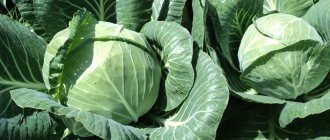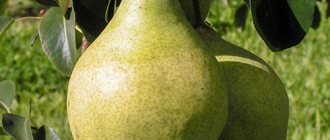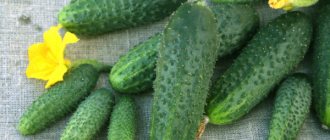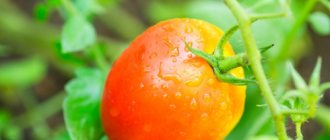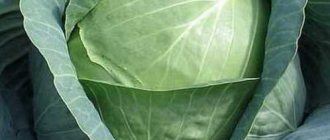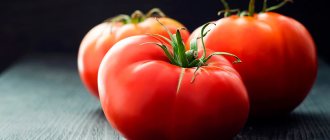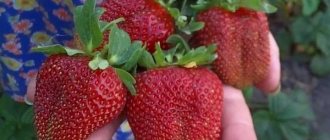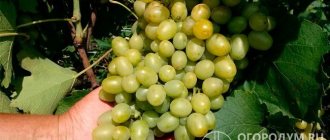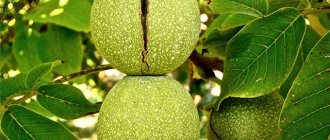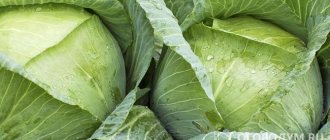Shetana onions are popular among gardeners because they have high yields and are quite easy to grow. This onion is rich in useful properties and is not too demanding to care for, so even a beginner can grow the crop in his garden.
Shetan's Bow
Shetan onion has white and juicy flesh
Shetan onion tolerates frost well
Description of Shetan's bow
The variety was bred in the Czech Republic specifically for cultivation in open ground. Onions tolerate frost well and ripen quickly.
Appearance
Visually, Shetan onions are easy to distinguish from other varieties of onion vegetables. It has a number of distinctive characteristics:
- The bulb has a round shape.
- The husk is colored characteristically yellow. The inside color of the husk is whitish.
- The leaves are quite long. They have a greenish color with the addition of a bluish tint.
- Neck thickness is medium.
- The flesh of Shetan onion is white and juicy.
- The approximate weight of one onion is 45 g. If the vegetable is grown from sets, then the onion weighs more - from 65 to 85 g.
Taste qualities
Shetan onions are chosen by many gardeners due to their taste. The vegetable is characterized by a bright semi-sharp taste, making it a universal herbal product. Therefore, this onion is widely used in cooking for preparing first and second courses, cold appetizers, and salads. It is used for pickling, baking and preservation.
Ripening time and yield
Shetana onion is a mid-early variety, so approximately 2.5-3 months after planting, the first harvest can be harvested. This ripening period is inherent in seed sowing. If planting occurs as sets, that is, small one-year-old onions are planted in the ground, the crop germinates much faster - in approximately 1-2.5 months.
Productivity directly depends on the region where the variety is grown. For example, if the central part of Russia became the place for growing onions, then about 5,000-5,800 kg of product are harvested from 1 hectare. In the southern regions, a much larger harvest is obtained from 1 hectare - from 20,000 to 25,000 kg.
Composition and properties
The onion vegetable has a composition rich in nutrients and microelements. It includes the following list of components:
- Saponins. These are complex compounds of plant glycosides.
- Onions contain both glucose and fructose.
- Pectin substances.
- Iron.
- Potassium.
- Fluorine.
- Vitamins in the form of ascorbic acid and tocopherol.
- Essential oils. They give the vegetable its characteristic smell.
Shetan onion helps treat anemia and also helps prevent it. A large amount of iron has this property.
Potassium improves heart function, strengthens the heart muscle, and vitamins restore immunity. Among other things, onions are a natural antiseptic. It is used during colds.
Advantages and disadvantages
The variety is chosen by many summer residents due to the presence of positive aspects, which include the following:
- the vegetable can be planted either by seeds or sets;
- early and high harvest;
- onions are frost-resistant;
- It does not require special care;
- is stored for a long time, retains its presentation and all its beneficial properties even after several months of storage;
- can be grown for sale as it withstands long-distance transport well.
Shetan onions have only one drawback - its main enemy is downy mildew.
Fruit characteristics
- The bulb is round.
- A head from seeds weighs on average 45 g, from a set - 65-85 g.
- Onion with three buds
- The upper scales of the onion are yellow.
- Inside the scales are medium density, white, juicy.
- The taste is semi-sharp.
- Ripening before harvesting is 85-100%, after ripening – 95-100%.
- Has good keeping quality. Can be stored until spring without losing taste and presentation.
Advice! It is recommended to store in dry rooms at a temperature of 15–20 degrees.
Preparing for landing
To reap a healthy and abundant harvest of Shetan onions, careful preparation is required before planting.
Soil preparation
Prepare the soil in the open ground in the fall. It is better to choose a place for the garden bed on the sunny side. It should not be flooded by groundwater, otherwise the entire crop may die.
It is necessary to plant Shetana onions in places where nightshade crops grew. An excellent bed is one where potatoes, cucumbers, herbs, radishes and tomatoes, as well as early varieties of cabbage, previously grew. It is forbidden to plant onions in a place where garlic, carrots, radishes and other varieties of onions grew.
Remember that the variety prefers to grow on loose, fertile soil with neutral acidity. If the soil is acidified, apply liming. This requires dolomite flour or ordinary ash.
To determine the acidity of the soil yourself, take some soil, dissolve it in a glass of water and dip in the litmus paper. If it turns red, it means the soil is acidified, and if it turns green, the acidity of the soil is normal.
Before digging the soil, do the following:
- Pour compost or humus into the soil (the use of fresh manure is unacceptable).
- Next, mineral fertilizers are added, which must contain three components: sulfate, potassium and complexes, for example, nitrophoska.
Plus, to improve the quality of the soil, sand, turf soil, and peat are added.
Before planting seeds to obtain future seedlings, also prepare the soil in advance:
- Take the soil and disinfect it with potassium permanganate or a fungicide solution. The solutions are used to water the soil.
- Next, mix the soil with sand, peat and humus.
If desired, the soil can be pre-steamed before planting the seeds.
Selection and preparation of seed material
It is best to purchase Shetan onion seeds and sets in specialized stores, since it is in such establishments that high-quality seed material is sold. But still, before purchasing, try to inspect the seeds and seedlings as carefully as possible.
To choose high-quality onion sets, pay attention to the following:
- The seedlings must have all the characteristic features of onions, that is, the yellowish color of the husk and white juicy pulp.
- Before you start purchasing, smell the bulbs. They should have a distinct onion smell. If they smell like mold, then such material is not suitable for planting, and it will not be possible to grow a crop.
- Sort the bulbs with your fingers. A quiet rustling sound should come from them. If it is missing, it means the seedlings are wet, but this should not be the case.
- Refrain from buying sets after winter. During frosts, the seedlings freeze, and after defrosting the bulbs will be rotten. Such planting material will not bring any results.
- If you are not planning to plant sets in the near future, then you should not purchase bulbs with roots and leaves that have already appeared.
- The seedlings must be clean, without stains, scratches, or whitish deposits.
- The ideal bulbs for planting are those that have a diameter of about 1-2 cm.
If, after purchasing planting material, there is a lot of time left before planting, it must be dried and placed in fabric or paper bags and put in a place where the air temperature does not rise above +10-15˚C. Air humidity should be between 70 and 75%. If the bulbs have already sprouted, put them in the refrigerator, preferably on the bottom shelf or in the vegetable compartment.
Before planting, the sets must be prepared. They begin to do this two weeks before disembarkation:
- Step one. Dry the seedlings and transfer to a warm place. The temperature should be around +20˚С.
- Step two. 8 hours before planting, seedlings should be kept at a temperature of +30 to +35˚С. This temperature regime can be achieved by installing a heater next to the set.
When choosing seeds, always pay attention to the expiration date of the planting material. Don't buy one that expires on or before the planting period. Remember that Shetan onion seeds last for a total of 3-4 years. If it is possible to count the seeds, then know that there are about 200-250 seeds per 1 g.
Seeds are also prepared before planting. To do this, a number of the following manipulations are performed:
- Step one. Inspect the material and select the strongest, most intact, light-colored seeds.
- Step two. Disinfect the seeds with a weak solution of potassium permanganate. Next, they are placed in the liquid for no more than twenty minutes.
- Step three. Transfer the onion seeds into a growth stimulator. For this purpose, the “Zircon” product is used.
Features of sowing seeds at home
Preparation for cultivation includes several stages:
- Soil preparation : removing weeds, fertilizing with compost or rotted manure. If the soil is acidified, then you need to add lime, but not earlier than a month before planting onions and applying fertilizer.
- Seed preparation : they are disinfected and made more resistant to damage by viruses. The seeds are soaked in warm water (+45°C) for a day, which helps destroy pathogenic bacteria. This also speeds up germination.
Preparation of planting material
Sowing of seeds in seedlings is carried out at the end of March. They are disinfected in a solution of potassium permanganate (1%) and treated with a growth stimulator. You can use Zircon for this.
It will provide protection against pathogenic microorganisms, and also improve metabolic processes in onions, accelerating its growth. Soak the seeds for about 8 hours. The dosage and duration of action of stimulants should be looked at on the packaging of the drug.
Selecting a container for planting
Seedlings are grown in containers of various textures and sizes. The most common type of container for onions is a seedling box. It can be wooden or plastic. If this is a new container, then before planting it is washed with soap. Last year's containers are also thoroughly washed and disinfected.
The process of planting seedlings and further care for them
Onion seeds are planted 4-6 weeks before the expected end of frost. If the feather has reached a height of 6 cm, then the seedlings begin to be taken outside, gradually increasing the residence time for hardening. The hardening period lasts 1–2 weeks.
Important! Onions should not be given to dogs. It can cause anemia and even death.
Technology for planting seeds for seedlings:
- Soil is placed in the seedling container. This could be a store-bought vegetable mix.
- Make shallow grooves.
- Seeds are sown in rows to a depth of 0.5 cm.
- Lightly moisten the soil with water.
- The container is installed in a place with good lighting.
- If you need to speed up germination, cover the container with plastic wrap.
The seeds will germinate in 4–10 days.
Features of transplanting into open ground
Plant seedlings in open ground before the last frost or immediately after it.
The sowing scheme is very simple:
- Furrows are made in the dug up, thoroughly loosened soil. The distance between them should not be less than 20 cm to avoid thickening of the plantings. The depth of the furrows is 1–2 cm.
- Seedlings are planted at a distance of 10 cm from each other.
Caring for crops consists of periodically loosening the soil, drip irrigation and killing weeds.
Read more about how to properly plant onions in the spring.
Technologies and planting times
Shetan onion is suitable for planting both in spring and before winter. Each season has its own technologies. Planting dates also affect a high yield; they must also be observed.
Winter landing
Before winter, onion vegetables are planted depending on the region. But the main condition is to have time to plant the seedlings 14 days before the onset of frost.
Pre-prepared bulbs are immersed in the ground to a depth of 4 cm. The diameter of the bulb should not exceed 1 cm.
The soil must be ready for planting two weeks before the planting procedure.
After planting the seedlings has come to an end, the soil is mulched - covered with any organic material in the form of sawdust, wood shavings, dry leaves. Or inorganic - small pebbles, gravel.
Planting seedlings in spring
Spring planting of Shetan onion sets is slightly different from winter planting. The vegetable is planted in May, when the soil is warm enough. Shortly before this, the soil and seedlings are prepared. Two hours before planting, future beds are watered abundantly.
For spring planting, bulbs with a diameter of 2 cm are required. They are immersed in holes to a depth of two centimeters. After the hole, water again. The soil is mulched.
When planting in spring and winter, make sure that there is about 5-7 cm between the holes, and the distance between the rows is from 15 to 20 cm. This way the vegetable receives the necessary warmth and the amount of sunlight required for healthy growth.
Diseases and pests
Shetan's onion is resistant to rot diseases, but suffers from dangerous downy mildew, that is, powdery mildew. This is an acute fungal infection that tends to spread quickly. Sick bulbs are very difficult to distinguish from healthy ones, so the disease can destroy the entire crop.
This disease appears in the form of a gray coating on the feathers of onions, which is clearly visible in the morning during dew. First, yellow spots form on the feathers, and then gray-violet spores.
To prevent peronosporosis, you must adhere to the following recommendations:
- choose sunny areas for planting where there have been no fungal infections before;
- do not plant onions thickly;
- Be sure to harvest the entire crop and dig up the beds in the fall.
If you plant onions according to all the rules and take care of them in the future, then a good harvest and high taste are guaranteed.
Rules of care
To get a large and healthy onion harvest, you need to carefully care for the vegetable.
Watering
The newly planted seedlings are watered with small portions of water as the soil dries out. As soon as hot weather sets in, onions are irrigated 2 times a week. An already formed turnip requires one watering per week.
Irrigate onions in the evening or in the morning, when the sun is not so active. Otherwise, the plant will receive severe burns. If it rains, you can refuse to water the beds. They finish irrigating the seedlings a couple of weeks before harvesting.
Loosening and weeding
As soon as the first shoots appear on the beds, it is necessary to regularly loosen and weed the soil. Carefully weed the area between the holes, trying not to touch the seedlings.
If weeds appear between the beds and around the holes, remove them manually. You need to loosen the beds after watering or rain. If this sequence is followed, weeds will not grow and harm the future harvest.
Fertilizer application
During the period of harvest ripening, it is necessary to fertilize the soil. There should be three feedings in total during the growing season:
- First feeding. It is carried out after the first shoots, 14 days after planting. Nitrogen fertilizers are applied to the soil.
- The second feeding occurs 14 days after the first. You will need organic fertilizers in the form of bird droppings. You can take mullein solution (cow dung).
- Third feeding. It is performed already at the moment of formation of the bulb. Take a mineral mixture that contains potassium and phosphorus in large proportions.
Disease and pest control
As already mentioned, Shetan onions are not resistant to downy mildew. The disease affects the vegetable if there is a sharp change in temperature or the humidity in the garden increases.
Among other things, onions are susceptible to disease and pests due to violations of the technologies for preparing planting material and planting in the ground.
If signs of disease are detected, do not use fungicidal agents for spraying. After treatment with such substances, onions are dangerous to eat. Use traditional methods. Whey is effective in a ratio of 1:10. Serum bacteria kill any fungal diseases on plants and are absolutely safe for humans.
Vegetables can also be damaged by onion flies. It is not the adults that are dangerous, but their larvae. When they fall into the ground, they eat the top part of the onion. To prevent such a nuisance, spray the beds with products that have a pungent odor. For such purposes, a decoction of mint, valerian, or pine infusion is suitable.
Advantages and disadvantages
Shetan's bow has many advantages, which are objectively greater than the disadvantages. The crop is undemanding to weather conditions and tolerates short-term frosts and drought. The yield is high, the taste is pleasant, and the shelf life is very long. Thanks to this, the Shetana variety managed to gain popularity among both summer residents and farmers.
Shetana is characterized by high yield and attractive presentation
Pros:
- good taste;
- bulbs aligned;
- keeping quality;
- transportability;
- excellent ripening (up to 100%);
- resistance to fusarium;
- the arrow gives practically no effect.
Minuses:
- no resistance to downy mildew;
- may suffer from onion flies and other pests.
Harvest and storage
Gentle onion leaves are the main sign that it’s time to go out into the garden and harvest. But don’t put off this task too much, otherwise the bulbs will take root and the vegetable will be impossible to preserve.
Shetan's onion stores well. But this should be facilitated and a number of rules followed:
- Once the crop has been harvested, dry it in place under the open sun. You can spread the onions directly on the beds, spreading newspapers.
- Next, sort through the onion heads, discarding those with blemishes.
- Trim the leaves, leaving about 10 cm.
- Dry the onion vegetable for several more days at a temperature of +25 to +10˚С.
- Afterwards, remove the crop to a permanent storage place, transferring it to boxes. Or hang your bows in nets. A basement, cellar or balcony in an apartment is suitable for this.
In the room where the onion harvest is stored, it is necessary to maintain a constant temperature from 0 to +5˚С. You can store it at room temperature, but make sure that it does not fluctuate sharply. The room with onions should be regularly ventilated.
Description and characteristics of the variety
- Shetana MS is a mid-early variety, the mature fruits of which are harvested 90 days after seed germination; when sowing sets, the fruits will ripen in 60-70 days.
- Entered into the State Register of the Russian Federation in 1998.
- Recommended for cultivation in the Central and Middle Volga regions; good harvests are achieved in all regions.
- Suitable for growing in gardens and small farms from seeds in an annual crop and from sets in a two-year crop.
- The feathers are long, green with a slight gray tint.
- The neck of the onion is medium in thickness.
- The yield in a one-year crop per 1 m2 is 0.6 kg, in a two-year crop 4 kg per square meter.
- It is more profitable to plant sets on turnips. Each bulb has 3 rudimentary buds, from which 3 onion heads are formed, weighing up to 80 g.
- Resistant to fusarium rot, but may be susceptible to downy mildew.
Useful tips
Shetan onion is easy to grow and care for. But despite this, pay attention to tips that help prevent diseases, achieve a rich harvest and ideal taste.
The main problem when growing onions is yellowness on the leaves. If it appears in July, there is no need to worry - this is a sign of rapid ripening. If the yellow color affects the leaves earlier than this month, this is no longer normal. This signal indicates several problems:
- Parasites. To protect onions from parasites, regularly loosen and weed the soil in the beds. Carrots help you forget about pests once and for all. Plant it next to the Shetan onion and its scent will repel any parasites. Wood ash also helps with solving the problem. Apply it to the soil in addition to basic fertilizers.
- Insufficient amount of nitrogen in the soil. To do this, apply fertilizers containing this component. In order for nitrogen to be absorbed into the soil, regular watering is needed. But if the weather is rainy, nitrogen can sink very deep into the ground, and the root system of the onion will not receive the component it needs.
- Little moisture. If the onion leaves turn yellow, water it a little more often than recommended. Do not allow the soil to dry out, especially in hot weather.
Also take note of the following useful tips:
- A mixture prepared from table salt (half a glass is required), 1 ampoule of ammonia and 3 handfuls of ash helps eliminate yellow leaves. All components are poured into 10 liters of water and mixed thoroughly. Water once every 10 days until the yellow color disappears completely.
- You can prevent the appearance of pests with this remedy: iodine – 0.5 tablespoon, soda – 0.5 kg, manganese – 2 packs. All ingredients are filled with water (5 liters needed). Next, dilute the resulting mixture with liquid in a ratio of 1:10 and pour over the onions.
- You can repel parasites with sand and mothballs. Scatter a mixture of them between the beds.
Often Shetan's onions start to taste bitter. This occurs due to insufficient watering. Do not forget to irrigate the future harvest, otherwise the dry matter content in the soil increases, and this causes an unpleasant taste. Also, for taste, fertilizers containing phosphorus are needed.
Caring for onions after planting
You will have to organize care for the onions. The soil must be loosened even before the first shoots appear . This will prevent the appearance of a crust on the surface of the earth, which will speed up germination. After this, this procedure is performed every two to three weeks. At the same time, weed removal is carried out.
You need to loosen the soil even before the onion shoots appear.
Fertilizer components must be applied before planting and during the entire growing season. At the time of digging the beds, it is necessary to add organic matter, for which chicken droppings and mullein can be used . The first fertilizing with organic substances dissolved in water is carried out when seedlings appear. The second time it is necessary to feed the plants when the height of the foliage reaches fifteen centimeters. It uses a mineral composition that has a lot of nitrogen. Potassium compounds are added at the time of expansion of the onion mass.
Watering is carried out twice a month , stopping completely three to four weeks before harvesting.
Reviews from gardeners
★★★★★
Vladimir, 67 years old. I like the Shetana onion variety for its taste and ease of planting and care.
I usually plant this vegetable with sets. I buy it from the manufacturer, sometimes in specialized vegetable stores. The fact that the variety is frost-resistant is a huge plus. After all, sometimes you want to treat yourself to a dish from Shetana in the spring. ★★★★★
Maria, 48 years old. One day I bought Shetana onion sets in a store, planted them and was surprised how quickly the first harvest appeared.
Now I plant vegetables every year. The onions are excellent, with a bright taste. Taking care of him is a real pleasure. ★★★★★
Gregory, 59 years old. For me, I love the Shetana variety because it is disease resistant and easy to care for.
I always plant this onion in my dacha, and would not exchange it for any other variety. ★★★★★
Evgeniy, 43 years old. I grow Shetana onions in my garden, as the variety stores well and does not lose its properties and qualities.
This is important to me because it facilitates trading. Another important aspect for choosing this variety is its ability to tolerate frost. Already in the spring you can harvest the crop and send it for sale. There is nothing to say about the taste - it is excellent and suitable for many culinary dishes. Hide
Add your review
Shetana onion is an excellent variety of onion that is popular among gardeners. Growing this vegetable is quite simple both in spring and in winter. To do this, you just need to properly prepare the seed and carry out further care. And useful advice from experts will help prevent diseases and even improve the taste of onions.
0
0
Copy link
Origin story
Shetana is a variety of onion bred by Czech agro breeders. Included in the Russian register of breeding achievements in 1998. Approved for cultivation in the regions of central Russia (including the Moscow region) and the Volga region.
It is recommended to grow in garden plots on private farms and on an industrial scale. It can be grown as an annual crop (from seeds) or as a biennial crop (planting sets).
Attention! The variety also has other names: “Chantane”, “Brown-haired”.
However, it is the “Shetan” form that is listed in the official register. It is also used by suppliers of planting material (seeds, onion sets “Shetana MS”).
Peculiarities
Shetan's characteristics are as follows:
- high level of productivity;
- fast ripening;
- long storage period;
- medium level of severity.
Shetana will appeal to picky gourmets. The fruits are mild in taste and lack strong pungency. The fair half of humanity prefers onions with such taste characteristics. This feature makes it so popular.
Description of chives varieties, features of cultivation and careRead
Shetan onion needs carefully selected soil. Predecessors are legumes and nightshades. A decrease in yield is observed after planting onions in places where garlic, cucumbers and asparagus grew. Favorable neighbors are bell peppers and carrots. Shetana is planted “before winter” or in early spring.
